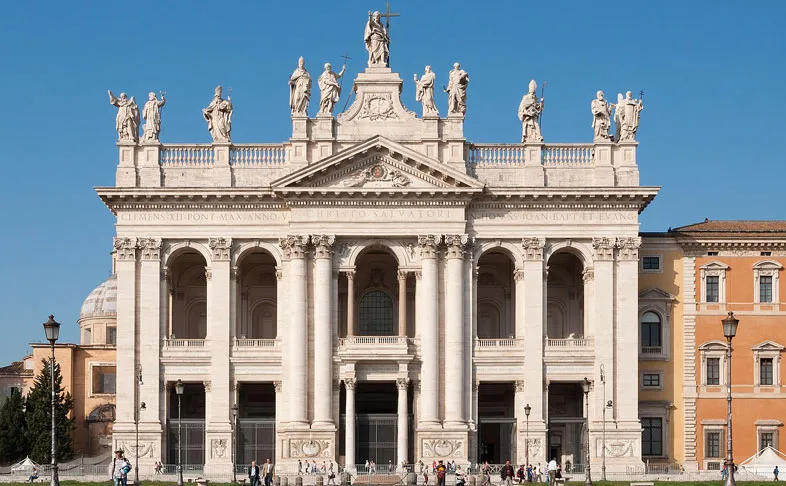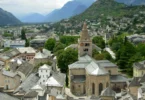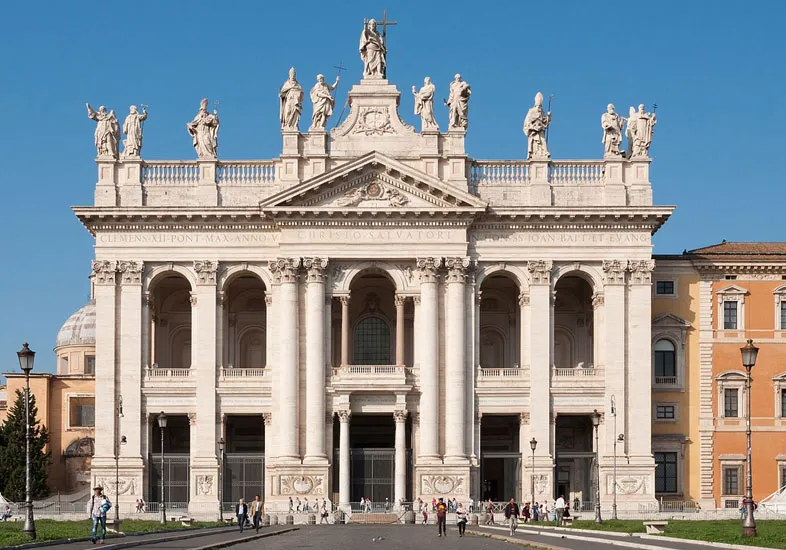
Introduction
The Archbasilica Cathedral of the Most Holy Savior and of Saints John the Baptist and John the Evangelist in the Lateran (Italian: Arcibasilica del Santissimo Salvatore e dei Santi Giovanni Battista ed Evangelista in Laterano), also known as the Papal Archbasilica of Saint John [in] Lateran, Saint John Lateran, or the Lateran Basilica, is the cathedral church of the Diocese of Rome in the city of Rome, and serves as the seat of the bishop of Rome, the pope.
The archbasilica of Saint John Lateran, Rome lies outside of Vatican City proper, which is located approximately 4 kilometres (2.5 mi) to the northwest. Nevertheless, as properties of the Holy See, the archbasilica and its adjoining edifices enjoy an extraterritorial status from Italy, pursuant to the terms of the Lateran Treaty of 1929. The church is the oldest and highest ranking of the four major papal basilicas as well as one of the Seven Pilgrim Churches of Rome, holding the unique title of “archbasilica”.
Originally founded in 324, it is the oldest public church in the city of Rome, and the oldest basilica of the Western world. It houses the cathedral of the Roman bishop, and has the title of ecumenical mother church of the Roman Catholic faithful. The building deteriorated during the Middle Ages and was badly damaged by two fires in the 14th century. It was rebuilt in the late 16th century during the reign of Pope Sixtus V. The new structure’s interior was renovated in the late 17th century, and its façade was completed in 1735 under Pope Clement XII.
The current rector is Cardinal Archpriest Angelo De Donatis, Vicar General for the Diocese of Rome. The President of the French Republic, currently Emmanuel Macron, is ex officio the “First and Only Honorary Canon” of the archbasilica, a title that the heads of state of France have possessed since King Henry IV. The large Latin inscription on the façade reads: Clemens XII Pont Max Anno V Christo Salvatori In Hon SS Ioan Bapt et Evang. This abbreviated inscription translates as: “Pope Clement XII, in the fifth year to Christ the Savior, in honor of Saints John the Baptist and [John] the Evangelist”.
The inscription indicates, with its full title, that the archbasilica was originally dedicated to Christ the Savior and, centuries later, co-dedicated to Saint John the Baptist and Saint John the Evangelist. Christ the Savior remains its primary dedication, and its titular feast day is 6 August, the Transfiguration of Christ. As the Cathedral of the Pope as Bishop of Rome, it ranks superior to all other churches of the Roman Catholic Church, including Saint Peter’s Basilica.
History of Archbasilica of Saint John Lateran, Rome

The Archbasilica of Saint John Lateran, Rome / The Archbasilica of the Holy Savior and of the Saints John the Baptist and the Evangelist, commonly known as San Giovanni in Laterano, is located near Mount Celio. It is the mater et caput of all the churches of Rome and the world. In this area, once stood a residence owned by the noble Lateran family. Their house stood near the Basilica, probably towards the current Via Amba Aradam, and the land covered the whole area which also includes the current basilica area.
According to the “Annals” of Tacitus in 65 these houses and lands were confiscated by the Emperor Nero, since Plautius Lateran, consul designated for the year 65, conspired against the emperor himself in the conspiracy known as the “Pisoni”. When the conspiracy failed, Plautius was sentenced to death and expropriated of his assets, which passed to the Imperial Treasury.
Subsequently (201 ca.) part of these lands were used by Septimius Severus, who to consolidate the staff of his bodyguard formed by the equites singulares (chosen knights) who had a barracks near the current Via Tasso, found himself in the the need to build a second barracks to welcome the new generation. He chose the Lateran area for this purpose, where the imperial treasury had various properties, first of all that of the Laterans, acquired with Nero’s confiscation.
In a part of these lands of the Laterans the emperor built a large military complex called Castra nova equitum singularium (New Barracks of the chosen guards). The excavations, conducted several times under the floor of the basilica and under the cloister, have brought to light various sections of the Severian foundations, and part of the elevation of the ground floor of the Barracks. In the same period, Septimius Severus donated another part of the confiscated land to Titus Sextio Laterano, a friend of Septimius Severus and his valiant commander in the Mesopotamian expedition.
It is not known whether the emperor donated the same house that belonged to Plautius Lateran or Titus Sextio or built a new one, but it would have been, in any case, such a luxurious and so important house as to constitute a topographical point of reference and, even after their disappearance, in the Middle Ages the buildings that stood in the area continued to be indicated with the phrase iuxta Lateranis (near the Lateran), up to the present denomination of the Lateran.
It must be said that it was thought of a relationship of kinship between the Lateran Plautius who died under the emperor Nero and the Titus Sextio Lateran friend of Septimius Severus. A distant kinship of the two characters cannot be completely excluded, it is also true that a precise relationship between these two people and their homes cannot be demonstrated.
Subsequently these lands became the property, it is not known whether by purchase or by inheritance, to a certain Fausta, as a domus Faustae is subsequently mentioned in the Lateran territory. We wanted to identify the Fausta in question with the second wife of the emperor Flavius Valerio Costantino (280-337), whose name is linked to the memory of the foundation of the Basilica.
Growing up at the court of Diocletian, Constantine was called to Britain by his father, the emperor Constantius Chlorus and upon his death he was acclaimed Augustus by the army (306), a fact that breaking the rules of the tetrarchic system, unleashed a violent struggle in which six pretenders (Maximian, Maxentius, Licinius, Galerius, Maximin and Constantine) contended for the imperial title.
Eliminated Maximian (310), Galerius died (311), Constantine on 28 October 312 defeated Maxentius at Saxa Rubra on the Via Flaminia (the Battle of Ponte Milvio), aided by that divine symbol that had appeared to him the night before his victory in a dream: an angel with a cross and an inscription IN HOC SIGNO VINCES, which Constantine promptly has painted on the shields of his soldiers.
Defeated Maxentius, Constantine goes to Milan and strengthens the alliance with Licinius, who, after Massimino died, remains master of the eastern provinces (subsequently Constantine also gets rid of Licinius, thus remaining the only Emperor). In Milan, Constantine also proclaimed an edict (313) in which he recognized freedom of worship for Christianity. Returning to Rome Constantine is concerned with offering the nascent church a suitable place to fully carry out its spiritual ministry.
At that time (4th century) in the Lateran area there were the domus Faustae, the house of Fausta, which, as already mentioned, was perhaps that Fausta wife of Constantine and sister of Maxentius, which Fausta herself had brought as a dowry to Constantine, and the Castra Nova Equites singularium. Constantine dissolves the body of the equites singulares , who had supported Maxentius and donated the land to Pope Melchiade to build a domus ecclesia.
The Archbasilica of Saint John Lateran, Rome was consecrated in 324 (or 318) by Pope Silvestro I, and dedicated to the Holy Savior. In the ninth century, Sergio III also dedicated it to San Giovanni Battista, while in the twelfth century. Lucio II also added St. John the Evangelist.
From the 4th century to the end of the Avignon period (14th century), in which the papacy moved to Avignon, the Lateran was the only seat of the papacy. The Patriarch, or Lateran residence (the ancient Papal seat), annexed to the Basilica was the residence of the Popes throughout the Middle Ages. The Lateran, therefore, was from this period up to the fourteenth century. the seat and symbol of the papacy and therefore, the heart of the life of the Church. Five ecumenical councils were also hosted there.
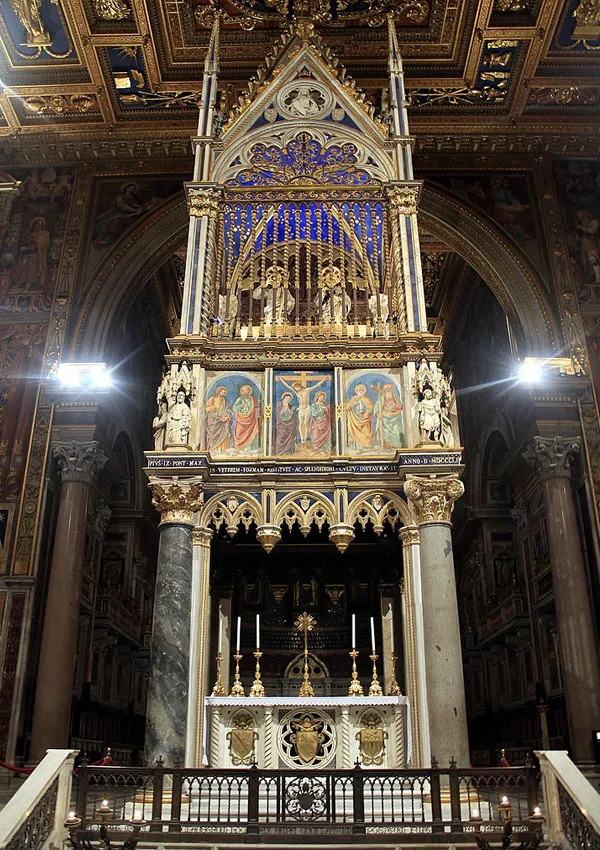
The Primitive Constantinian Basilica was very similar in plan to the current one, also with five naves, and the perimeter walls more or less coincide with the current ones. A rectangular hall divided internally into five naves by marble colonnades with Corinthian capital; 15 columns with high entablature on each side of the main nave and 21 columns supporting arches between the aisles. At the end of the central nave, to the west, there was a large apse. In the early Middle Ages the Cathedral was a precious treasure chest of works of art. Already the emperor Constantine, after having wanted the great Basilica, enriched it with a wonderful ciborium for the main altar.
But after the first splendours of the fourth century, events followed that marked the complex history of the Lateran Archbasilica for over a millennium, up to the present day. At the beginning of the fifth century. during the Visigothic sack of Alaric in 410, the cathedral was stripped of the precious Constantinian canopy, immediately replaced by Sixtus III. In 455 the vandals of Genseric plundered the Church of all its treasures.
Pope Hilary (461-468) had three oratories built around the Baptistery, those of: San Giovanni Battista, San Giovanni Evangelista and that of the Holy Cross, the latter demolished by the Baroque renovations of Sixtus V. The oratory of San Venanzio was instead built in the sixth century. under the papacy of John IV. At the beginning of the nineth century. Leo III rebuilt the ceilings of the basilica and decorated the windows of the apse with polychrome stained glass. In the 10th century An oratory dedicated to St. Thomas was built on one side of the portico, which in ancient times was used by the Popes to wear liturgical clothes before entering the church.
In the twelfth century. the roof of the Basilica was restored and the portico of the Baptistery adapted to two chapels (dedicated to S.ta Rufina and Secondo and to San Cipriano and Giustina); in the same century the ancient facade of the Basilica was rebuilt with the mosaic decoration and the entrance portico, as well as the endowment of bronze doors in the baptistery and in the Scala Santa, now in the chapels of the two San Giovanni, inside the baptistery.
At the end of the thirteenth century. great works were undertaken under Boniface VIII for the Jubilee of 1300, with the new loggia of blessings and the frescoes by Giotto (or Giotteschi) and Cimabue, now lost. The Jubilee of 1300 was the first great Jubilee in history, announced in San Giovanni in Laterano. In the fourteenth century. the main event, and decisive for the history of the Lateran Basilica, is the shift of papal power from Rome to Avignon, and therefore the complete abandonment of the Lateran.
In 1378 with the election of Gregory XI, we have the end of the Avignon period. Gregory XI brings the papacy back to Rome, but with the Lateran in poor condition, the popes will from now on prefer the Vatican.
From this period on, all the restorations will be aimed exclusively at the care of the Basilica and the Baptistery, while the Patriarch is slowly left to go to ruin. In the 15th century, Pope Martin V, from 1426 to 1431, provided for a reconstruction of the floor and wall paintings by Gentile da Fabriano and Pisanello. From 1431 to 1447, under Eugene IV, the crumbling columns of the nave were covered with bricks and the arches turned in place of the straight entablatures. This was an important turning point, from an architectural point of view, which fixed the structural order faced by Borromini two centuries later for its total rebuilding.
In the sixteenth century, after the sack of Rome, Paul III proposed to demolish the Patriarch to obtain tiles and beams for the restoration of the church, suppressed the annular portico of the Baptistery and modified the dome with today’s octagonal drum, covered with a lead roof. Pius IV embellished the Baptistery and built the ceiling of the Basilica, which Pius V continued. At the end of this century Sixtus V had the Patriarch completely demolished to build the Lateran Apostolic Palace (now the seat of the Vicariate of Rome), by the architect Domenico Fontana, and with it the elevation of the north transept.
For the Jubilee of 1600 Clement VIII renewed the transept and the altar of the Blessed Sacrament on a project by Giacomo della Porta. The total rearrangement of the Basilica by Francesco Borromini, who rebuilt the central and side aisles, dates back to 1650. This intervention was commissioned by Pope Innocent X and completed in 1660 under the papacy of Alexander VII, who also restored the mosaic of the apse and transferred the bronze doors of the ancient Roman Curia from the Church of Sant’Adriano to the Roman Forum. which today constitute the great central door of the Basilica.
In the eighteenth century, continuing the work that privileged the completeness of the external image, the facade of the Basilica was finally completed with the new elevation by Alessandro Galilei (also author of the Corsini Chapel inside the Basilica), completed a few years before the Jubilee from 1750. The statues of the 12 Apostles are placed in the Borrominian niches inside the Basilica.
The last major restoration took place in the 19th century, first under Pius IX, who restored the tabernacle and the confession; then, the most conspicuous one, under Leo XIII who from 1876 to 1886 commissioned the architect Francesco Vespignani to tear down the apse and rebuild it further behind. In the twentieth century under Pius XI there was the restoration of the Cosmatesque floor, where the remains of the ancient barracks of the equites singulares were found. On the occasion of the great Jubilee of 2000, the new Holy Door was inaugurated, the work of the sculptor Floriano Bodini (1933-2005)
Architecture of Archbasilica of Saint John Lateran, Rome

Architectural Styles: Early Christian Architecture, Baroque Architecture, Neoclassical Architecture.
Architects: Domenico Fontana, Giacomo della Porta, Alessandro Galilei, Francesco Vespignani, Giovanni di Stefano.
An apse lined with mosaics and open to the air still preserves the memory of one of the most famous halls of the ancient palace, the “Triclinium” of Pope Leo III, which was the state banqueting hall. The existing structure is not ancient, but some portions of the original mosaics may have been preserved in the tripartite mosaic of its niche. In the center Christ gives to the Apostles their mission; on the left He gives the Keys of the Kingdom of Heaven to Pope Saint Sylvester I and the Labarum to Emperor Constantine I; and on the right Saint Peter gives the Papal stole to Pope Leo III and the standard to Charlemagne.
Some few remains of the original buildings may still be traced in the city walls outside the Gate of Saint John, and a large wall decorated with paintings was uncovered in the 18th century within the archbasilica behind the Lancellotti Chapel. A few traces of older buildings were also revealed during the excavations of 1880, when the work of extending the apse was in progress, but nothing of importance was published.
A great many donations from the Popes and other benefactors to the archbasilica are recorded in the Liber Pontificalis, and its splendor at an early period was such that it became known as the “Basilica Aurea”, or “Golden Basilica”. This splendor drew upon it the attack of the Vandals, who stripped it of all its treasures. Pope Leo I restored it around AD 460, and it was again restored by Pope Hadrian.
In 897, it was almost totally destroyed by an earthquake: ab altari usque ad portas cecidit (“it collapsed from the altar to the doors”). The damage was so extensive that it was difficult to trace the lines of the old building, but these were mostly respected and the new building was of the same dimensions as the old. This second basilica stood for 400 years before it burned in 1308. It was rebuilt by Pope Clement V and Pope John XXII. It burned once more in 1360, and was rebuilt by Pope Urban V.
Through vicissitudes the archbasilica retained its ancient form, being divided by rows of columns into aisles, and having in front a peristyle surrounded by colonnades with a fountain in the middle, the conventional Late Antique format that was also followed by the old Saint Peter’s Basilica. The façade had three windows and was embellished with a mosaic representing Christ as the Savior of the world.
The porticoes were frescoed, probably not earlier than the 12th century, commemorating the Roman fleet under Vespasian, the taking of Jerusalem, the Baptism of Emperor Constantine I and his “Donation” of the Papal States to the Catholic Church. Inside the archbasilica the columns no doubt ran, as in all other basilicas of the same date, the whole length of the church, from east to west.
In one of the rebuildings, probably that which was carried out by Pope Clement V, a transverse nave was introduced, imitated no doubt from the one which had been added, long before this, to the Basilica of Saint Paul Outside the Walls. Probably at this time the archbasilica was enlarged.
Some portions of the older buildings survive. Among them the pavement of medieval Cosmatesque work, and the statues of Saint Peter and Saint Paul, now in the cloister. The graceful ciborium over the high altar, which looks out of place in its present surroundings, dates from 1369. The stercoraria, or throne of red marble on which the Popes sat, is now in the Vatican Museums. It owes its unsavory name to the anthem sung at previous Papal coronations, “De stercore erigens pauperem” (“lifting up the poor out of the dunghill”, from Psalm 112).
From the 5th century, there were seven oratories surrounding the archbasilica. These before long were incorporated into the church. The devotion of visiting these oratories, which was maintained through the Mediaeval Ages, gave rise to the similar devotion of the seven altars, still common in many churches of Rome and elsewhere.
Of the façade by Alessandro Galilei (1735), the cliché assessment has ever been that it is the façade of a palace, not of a church. Galilei’s front, which is a screen across the older front creating a narthex or vestibule, does express the nave and double aisles of the archbasilica, which required a central bay wider than the rest of the sequence. Galilei provided it, without abandoning the range of identical arch-headed openings, by extending the central window by flanking columns that support the arch, in the familiar Serlian motif.
By bringing the central bay forward very slightly, and capping it with a pediment that breaks into the roof balustrade, Galilei provided an entrance doorway on a more than colossal scale, framed in the paired colossal Corinthian pilasters that tie together the façade in the manner introduced at Michelangelo’s palace on the Campidoglio. In the narthex of the church, is a 4th century statue of emperor Constantine. It was found elsewhere in Rome, and moved to this site by order of Pope Clement XII.
Our Lady of Confidence

Our Lady of Confidence, also known as La Madonna della Fiducia or Our Lady of Trust, is a venerated image depicting the Blessed Virgin Mary enshrined at the Lateran Basilica. The feast of Our Lady of Confidence falls on the last Saturday prior to Lent.
The picture was painted by the great Italian painter Carlo Maratta (1625-1713), who was knighted by Pope Clement XI in 1704 and made court painter by Louis XIV the same year. It is said that the renowned artist gave this painting to a young noble woman, who would become the Abbess of the Convent of Poor Clares of St. Francis in the city of Todi.
There are two different traditions associated with the painting. One holds that it was painted by a religious sister in the eighteenth century. The other states that it was painted by Carlo Maratta, who gave it to a young noblewoman who later became Abbess of the Convent of the Poor Clares in Todi, Italy.
Devotion to the Blessed Virgin Mary under the title “Our Lady of Confidence” can be traced back to Sr. Chiara Isabella Fornari, who was a Poor Clare in Todi, Italy. The image is especially noteworthy in that Christ points to his mother, and Mary’s intercession is typically invoked through the short prayer “Mater Mea, Fiducia Mea” (My Mother, My Confidence).
When Carlo Maratta was 25 years old, his work was so well received that he was brought to Rome by Cardinal Albrizio and the governor of his home district of Ancona. After his introduction to Pope Alexander VII he received many commissions, which brought him renown throughout Europe. He was eventually knighted by Pope Clement XI in the year 1704 and was made court painter by Louis XIV during the same year.
Known for his portraits, especially those of the popes and portraits of the Madonna and Child, his religious works are said to be “marked by a certain strength and nobility, coupled with a gracious harmony.” Never was this more true and in a special manner than this picture of Our Lady of Confidence, which came into the possession of Sister Chiara Isabella Fornari [1697-1744], a young nun of the Poor Clare Convent at Todi, Italy. It is believed that the artist gave the image to the young nun.
Because of this special image, Sister Chiara Isabella and the other sisters were drawn to a deep and intimate relationship with Our Lady, who showed her approval through unusual cures and conversions. Our Lady once indicated her liking for the portrait by appearing to Sister Chiara Isabella, when the Blessed Virgin promised the nun that she would grant a particular tenderness and devotion toward herself to everyone who venerates her image in the picture of Our Lady of Confidence. Combined with the aspiration, “My Mother, my confidence,” this devotion has proven especially efficacious.
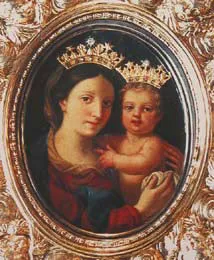
Because of the number of requests, copies of the portrait were made. One was placed in the small students’ chapel of St. Mary’s Seminary at the Lateran Basilica in Rome. During World War I, over 100 seminarians who were forced into the armed services of Italy returned home safely, the special grace, attributed to Our Lady of Confidence, and it was this favor which prompted the seminarians to crown both Mother and Child with diadems of gold and jewels.
While a student at the seminary, Pope John XXIII became a devotee of Our Lady of Confidence. He frequently visited the holy image and honored it still more by offering his first Mass in its presence. Afterward, he continued his visits to Our Lady of Confidence and offered Mass there, especially on the second Sunday in Lent, the Feast of Our Lady of Confidence. In the image, notice that the Christ Child points towards His Mother, the source of graces and confidence.
That Abbess, today Venerable Sister Clara Isabel Fornari, embraced a severe life of penance and was favored with many mystical graces; she even received the Sacred Stigmata of Our Lord’s Passion. Sister Clara Isabel had a great devotion to the Blessed Mother, like all the saints, and a very special attachment to this maternal image of Our Lady with the Divine Infant. For Our Lady had made a remarkable promise to Sister Clara Isabel that would win special graces for herself, her sisters and all those through the ages who would venerate this image.
Due to numerous cures and conversions worked through the intercession of Our Lady of Confidence, copies of the portrait were made and circulated. One of these copies was placed in the small chapel of St. Mary’s Seminary at the Lateran Basilica in Rome. The seminarians soon realized that their prayers and needs were always attended to by the Madonna della Fiducia.
Further, Our Lady of Confidence protected them in times of crisis. She granted the seminarians full protection against the scourge of Asiatic flu, which claimed many lives in Rome in 1837, and again some thirty years later. During World War I, when over one hundred seminarians were forced into the armed services of Italy, they placed themselves under her special care. All returned home safely. To repay the goodness of their Queen, the seminarians crowned both Mother and Child with golden bejeweled diadems.
This image encourages and inspires that confidence. In keeping with the Renaissance style of depicting Our Lady and the saints as regional types, the Blessed Virgin, with her auburn hair, hazel eyes and soft complexion, appears as a northern Italian beauty. Serene and noble, She bears in her arms her great Treasure, Who has the commanding air of a Great Prince. With a surprising imperative gesture, Our Lord points directly to His Mother, as if to tell us, “If you would come to Me, go to her. For what she asks of Me, I will give her.”
The picture teaches us what the Holy Church has always instructed: Our Lord Jesus Christ always acts through Mary as a channel. All conversions and favors take place by means of and through the intercession of this Blessed Mother. We need only approach with the confidence of a child in his mother to be certain she will attend to our needs. Mankind today does not have this lively confidence in the maternal love of Our Queen, and, because of this, we do not take advantage of the universal channel of grace for mankind.
Pope Gregory XVI granted a Canonical Coronation to the image on 14 October 1838, via Cardinal Carlo Odescalchi, at the requested petition of the Roman seminarians. In addition, Pope Pius X was particularly devoted to Mary under this title.
Rome's Pontifical Major Seminary
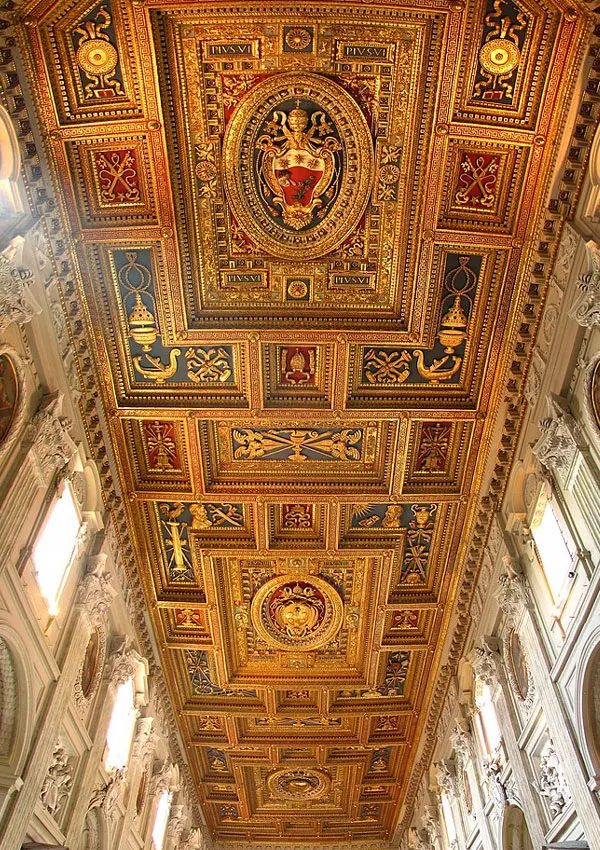
Originally, this Madonna was located at the Jesuit Collegio Romano, where it is believed she protected the seminarians from the Asiatic flu epidemic of 1837, which claimed many lives in Rome. To repay her, the seminarians crowned both Mother and Child with golden bejeweled diadems. The Patroness of Rome’s Major Seminary is the Blessed Virgin Mary under the title Madonna della Fiducia. A “miraculous copy” of Our Lady of Confidence now resides at the Roman Major Seminary located in the Basilica of Saint John Lateran complex.
Pope John Paul II started the papal tradition of venerating this miraculous image each year; subsequently, Pope Benedict XVI carried on the tradition. During his visit on the feast day of Our Lady of Confidence on 9 February 2002, Pope John Paul II ended his time at the seminary commenting on the devotion his predecessors had to Mary as Madonna della Fiducia, saying, we heard how Our Lady of Confidence guided the steps of Pope John XXIII on a path that brought him from this Seminary to the Second Vatican Council, which was also a great seminary, the seminary of the bishops of the world.
Let us thank Our Lady of Confidence for all that she did to assist Pope John XXIII in the preparation for and in the adventure of the Second Vatican Council.
Statues of the Apostles
The Archbasilica of Saint John Lateran, Rome – The twelve niches created in Francesco Borromini’s architecture were left vacant for decades. When in 1702 Pope Clement XI and Benedetto Cardinal Pamphili, archpriests of the archbasilica, announced their grand scheme for twelve larger-than-life sculptures of the Apostles (Judas Iscariot replaced by Saint Paul, with Saint Matthias missing) to fill the niches, the commission was opened to all the premier sculptors of late Baroque Rome.
Each statue was to be sponsored by an illustrious prince with the Pope himself sponsoring that of Saint Peter and Cardinal Pamphili that of Saint John the Evangelist. Most of the sculptors were given a sketch drawn by Pope Clement’s favorite painter, Carlo Maratta, to which they were to adhere, but with the notable exception being Pierre Le Gros the Younger, who successfully refused to sculpt to Maratta’s design and consequently was not given a sketch.
Papal Tombs
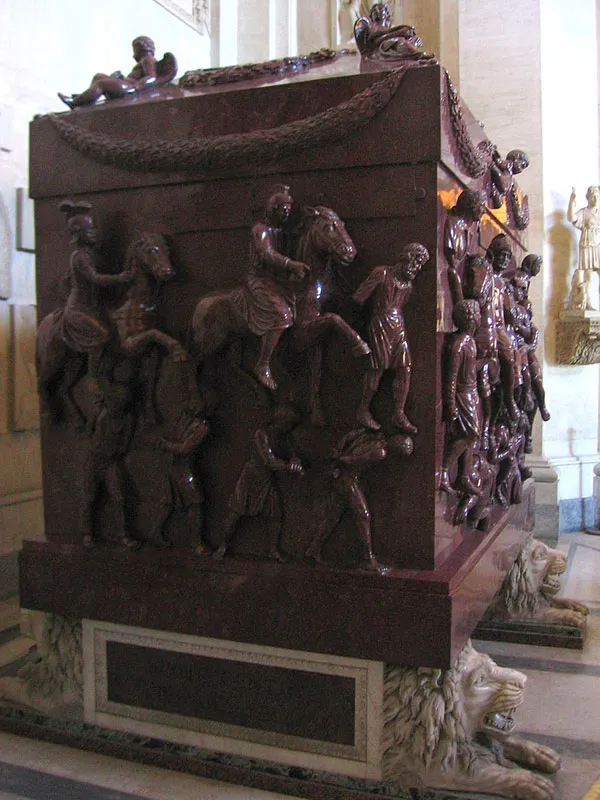
There are six extant papal tombs inside the Archbasilica of Saint John Lateran, Rome -Alexander III (right aisles), Pope Sergius IV (right aisles), Pope Clement XII Corsini (left aisle), Pope Martin V (in front of the confessio); Pope Innocent III (right transept); and Pope Leo XIII (left transept), by G. Tadolini (1907). The last of these, Pope Leo XIII, was the last pope not to be entombed in Saint Peter’s Basilica. Twelve additional papal tombs were constructed in the archbasilica starting in the 10th century, but were destroyed during the two fires that ravaged it in 1308 and 1361. The remains of these charred tombs were gathered and reburied in a polyandrion.
The popes whose tombs were destroyed are: Pope John X (914–928), Pope Agapetus II (946–955), Pope John XII (955–964), Pope Paschal II (1099–1118), Pope Callixtus II (1119–1124), Pope Honorius II (1124–1130), Pope Celestine II (1143–1144), Pope Lucius II (1144–1145), Pope Anastasius IV (1153–1154), Pope Clement III (1187–1191), Pope Celestine III (1191–1198), and Pope Innocent V (1276). Popes who reigned during this period, whose tombs are unknown, and who may have been buried in the archbasilica include Pope John XVII (1003), Pope John XVIII (1003–1009), and Pope Alexander II (1061–1073).
Pope John X was the first pope buried within the walls of Rome, and was granted a prominent burial due to rumors that he was murdered by Theodora during a historical period known as the saeculum obscurum. Cardinals Vincenzo Santucci and Carlo Colonna are also buried in the archbasilica. The skull of Saint Peter is also claimed to reside in the archbasilica since at least the ninth century, alongside the skull of Saint Paul.
Lateran Palace

The Archbasilica of Saint John Lateran, Rome stands over the remains of the Castra Nova equitum singularium, the “New Fort of the Roman imperial cavalry bodyguards”. The fort was established by Septimius Severus in AD 193. Following the victory of Emperor Constantine the Great over Maxentius (for whom the Equites singulares augusti, the emperor’s mounted bodyguards had fought) at the Battle of the Milvian Bridge, the guard was abolished and the fort demolished. Substantial remains of the fort lie directly beneath the nave.
The remainder of the site was occupied during the early Roman Empire by the palace of the gens Laterani. Sextius Lateranus was the first plebeian to attain the rank of consul, and the Laterani served as administrators for several emperors. One of the Laterani, Consul-designate Plautius Lateranus, became famous for being accused by Nero of conspiracy against the Emperor. The accusation resulted in the confiscation and redistribution of his properties.
The Lateran Palace fell into the hands of the Emperor when Constantine I married his second wife Fausta, sister of Maxentius. Known by that time as the Domus Faustae or “House of Fausta,” the Lateran Palace was eventually given to the Bishop of Rome by Constantine I.
The actual date of the donation is unknown, but scholars speculate that it was during the pontificate of Pope Miltiades, in time to host a synod of bishops in 313 that was convened to challenge the Donatist schism, declaring Donatism to be heresy. The palace basilica was converted and extended, becoming the residence of Pope Saint Sylvester I, eventually becoming the Cathedral of Rome, the seat of the Popes as the Bishops of Rome.
Holy Stairs
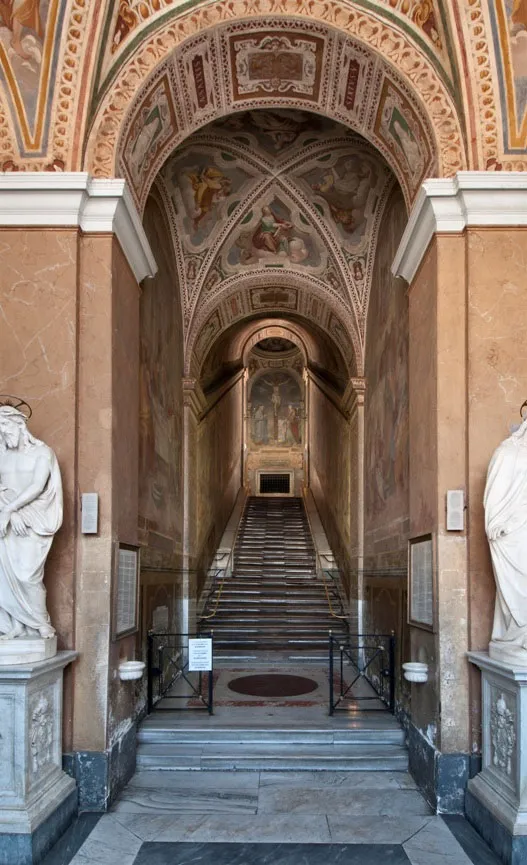
The Archbasilica of Saint John Lateran, Rome – The Scala Sancta, or Holy Stairs, are white marble steps encased in wooden ones. They form the staircase which once led to the praetorium of Pontius Pilate in Jerusalem and which, therefore, were sanctified by the footsteps of Jesus Christ during His Passion. The marble stairs are visible through openings in the wooden risers.
Their translation from Jerusalem to the Lateran Palace in the 4th century is credited to Saint Empress Helena, the mother of the then-Emperor Constantine I. In 1589, Pope Sixtus V relocated the steps to their present location in front of the ancient palatine chapel named the Sancta Sanctorum. Ferraù Fenzoni completed some of the frescoes on the walls.
Early Church
Pope Sylvester I presided over the official dedication of the archbasilica and the adjacent Lateran Palace in 324, changing the name from Domus Fausta to Domus Dei (“House of God”), with a dedication to Christ the Savior (Christo Salvatori). When a cathedral became a symbol of episcopal authority, the papal cathedra was placed in its interior, rendering it the cathedral of the Pope as Bishop of Rome.
When Gregory the Great sent the Gregorian mission to England under Augustine of Canterbury, some original churches in Canterbury took the Roman plan as a model, dedicating a church both to Christ as well as one to Saint Paul, outside the walls of the city. The church name “Christ Church”, so common for churches around the world today in Anglophone Anglican contexts, originally came from this Roman church, central to pre-medieval Christian identity.
The Middle Ages
On the Archbasilica of Saint John Lateran, Rome the front wall between the main portals is a plaque inscribed with the words “SACROS LATERAN ECCLES OMNIUM VRBIS ET ORBIS ECCLESIARVM MATER ET CAPUT” (“Most Holy Lateran Church, mother and head of all the churches in the city and the world”); a visible indication of the declaration that the basilica is the “mother church” of all the world. In the twelfth century the canons of the Lateran claimed that the high altar housed the Ark of the Covenant and several holy objects from Jerusalem. The basilica was thus presented as the Temple of the New Covenant.
The Archbasilica of Saint John Lateran, Rome and Lateran Palace were re-dedicated twice. Pope Sergius III dedicated them to Saint John the Baptist in the 10th century in honor of the newly consecrated baptistry of the archbasilica. Pope Lucius II dedicated them to John the Evangelist in the 12th century. Thus, Saint John the Baptist and Saint John the Evangelist became co-patrons of the archbasilica, while the primary Patron is still Christ the Savior, as the inscription in the entrance indicates and as is traditional for patriarchal cathedrals.
Consequently, the Archbasilica of Saint John Lateran, Rome remains dedicated to the Savior, and its titular feast is the Feast of the Transfiguration of Christ on 6 August. The archbasilica became the most important shrine of the two Saint Johns, albeit infrequently jointly venerated. In later years, a Benedictine monastery was established in the Lateran Palace, and was devoted to serving the archbasilica and the two saints.
Every pope, beginning with Pope Miltiades, occupied the Lateran Palace until the reign of the French Pope Clement V, who in 1309 transferred the seat of the Papacy to Avignon, a Papal fiefdom that was an enclave in France. The Lateran Palace has also been the site of five ecumenical councils (see Lateran Councils).

Lateran Fires
During the time the papacy was seated in Avignon, France, the Lateran Palace and the archbasilica deteriorated. Two fires ravaged them in 1307 and 1361. After both fires the pope sent money from Avignon to pay for their reconstruction and maintenance. Nonetheless, the archbasilica and Lateran Palace lost their former splendor.
When the papacy returned from Avignon and the pope again resided in Rome, the archbasilica and the Lateran Palace were deemed inadequate considering their accumulated damage. The popes resided at the Basilica di Santa Maria in Trastevere and later at the Basilica di Santa Maria Maggiore. Eventually, the Palace of the Vatican was built adjacent to the Basilica of Saint Peter, which existed since the time of Emperor Constantine I, and the popes began to reside there. It has remained the official residence of the pope (though Pope Francis unofficially resides elsewhere in the Vatican City).
Feast Day – 9th November
The anniversary of the dedication of this church has been observed as a feast in Roman Catholicism only since the 12th century, a time of increasing centralization of papal authority in the history of the Church. In the General Roman Calendar of the Catholic Church, 9th November is the feast of the Dedication of the (Arch) Basilica of the Lateran (Dedicatio Basilicae Lateranensis), and is referred to in older texts as the “Dedication of the Basilica of the Most Holy Savior”. In view of its role as the mother church of the world, this liturgical day is ranked worldwide as a feast.
Mass Time
Weekdays
- 7:00 am (Altar of the Blessed Sacrament)
- 7:30 am (Cappella Massimo) July and August suspended
- 8:00 am (Chapel Adoration)
- 9:00 am (Cappella Massimo)
- 10:00 am (Cappella Massimo) July and August suspended
- 11:00 am (Cappella Massimo) July and August in the Adoration Chapel
- 12:00 (Noon) (Chapel of Adoration) July and August suspended
- 5:30 pm (Chapel of Adoration)
Saturdays
- 3:45 pm only on Saturdays when Confirmation is celebrated (Papal Altar) July and August suspended
- 5:30 pm (Papal Altar)
Sundays
- 7:00 am (Altar of the Blessed Sacrament)
- 8:00 am (Adoration Chapel)
- 9:00 am (Papal Altar)
- 9:45 am Celebration of Lauds (Papal Altar)
- 10:30 am (Papal Altar)
- 12:00 (Noon) (Papal Altar)
- 5:30 pm (Papal Altar)
Church Visiting Time
Every Days : 7:00 am to 6:30 pm
Contact Info
Piazza di S. Giovanni in Laterano,
4, 00184, Roma RM, Italy
Phone No.
Tel : +39 06 6988 6433
Accommodations
How to reach the Basilica
Rome Ciampino Airport (CIA) is the nearby airport to the Basilica.
Porta S. Giovanni / Carlo Felice is the nearby train station to the Basilica.

